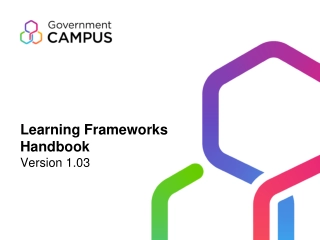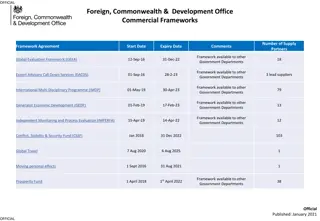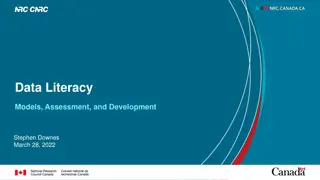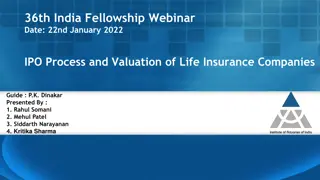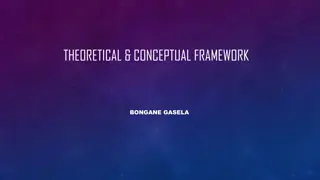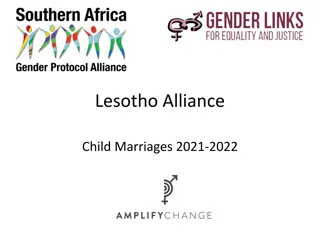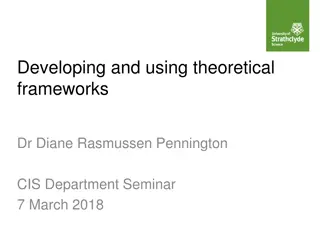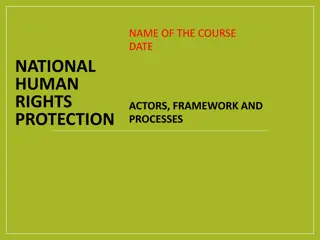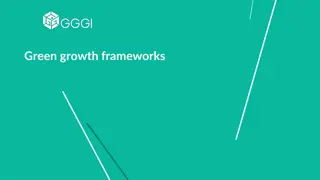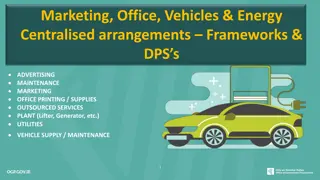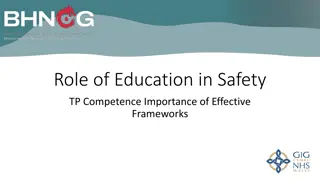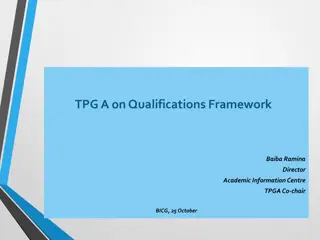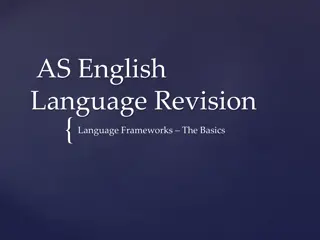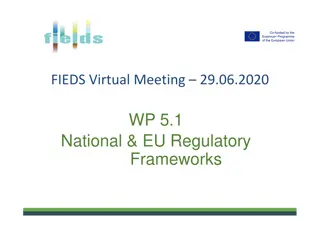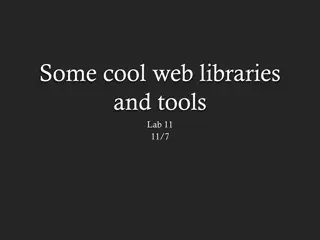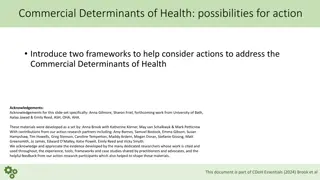Exploring Modern Service Systems & Community Frameworks
Delve into the experiences and insights shared by Bill Krebs and Dana Olsen, experienced professionals in the human services sector. Understand the challenges and opportunities in modern service systems, along with strategies to step out of traditional assumptions towards innovative approaches. Explore the importance of community frameworks that prioritize individual outcomes and empowerment, paving the way for a more inclusive society.
Uploaded on Sep 21, 2024 | 0 Views
Download Presentation

Please find below an Image/Link to download the presentation.
The content on the website is provided AS IS for your information and personal use only. It may not be sold, licensed, or shared on other websites without obtaining consent from the author. Download presentation by click this link. If you encounter any issues during the download, it is possible that the publisher has removed the file from their server.
E N D
Presentation Transcript
APSE Breakout Session Try Another Way: Why Modern Systems Don t Work and What Can
Im Bill Krebs -In the process of being employed as a travel trainer so people can get to their jobs. I have been wanting this job for years. I hope to have my own business someday, and I m real good at what I do. -The non-profit organization that has supported me is funded by various service systems including the Pennsylvania Offices of Developmental Programs and Vocational Rehabilitation in Philadelphia. -These organizations and others constitute my current system relationships, though I have others, going back to sheltered work and education. -I am also engaged with a number of organizations dedicated to self- determination, independent monitoring for quality, and employment, including the Pennsylvania APSE on which I serve as a state board member.
Im Dana Olsen System veteran of 33 years with Pennsylvania Office of Developmental Programs, where I helped start the Community Living Arrangements (CLA)program, PASS, employment first, lifesharing, Independent Monitoring for Quality (IM4Q),and other statewide initiatives. My career in human services began in 1973, at a sheltered workshop called the Shut In Society. I stay in this work because it feels right. With my current involvement in PA- APSE, a history coalition honoring people with disability, the state DD Council, and writing, I m in as deep now as ever. I ve been a presentation partner with my friend Bill Krebs for a decade. I appreciate that he s smart, fun, a great dresser, and fearless. He makes an excellent speaker and facilitator as you are about to appreciate.
And You Are 1. Individual receiving disability services, life-sharer, loved one, neighbor, advocate, family member, 2. System funded direct support worker, employment specialist, job coach, residence manager, life-sharer, or family member. 3. A friend, citizen advocate, life-sharer, volunteer who provides support without system compensation 3. Policy or system wonk, program development specialist 4. Organization executive, administrator, program director 5. Program monitor, auditor, case-manager, inspector, evaluator 6. Academician, student, and researcher, indenpendent analyst
Just To Be Clear How many of you have worked in the same or a similar service system for 5 years or less? How many of you have worked in or with human service systems for 20 years or more?
What Were Doing Here Walking through some mental exercises . The first set of exercises reviews how service systems stand up to the everyday living outcomes that people seek in life The second set engages a simple process to step out of system assumptions in considering new ways The third set considers characteristics of community frameworks that walk the talk
On The Basics Do we generally agree that: Human services have a fundamental responsibility to support people with disability in securing a job, a home, and community resources. People receiving services deserve to decide where, how and with whom they live, work, and utilize community resources Services must be safeguarded to ensure health, safety, rights, and cost-effectiveness
Bills Take and Others In your life, how well has the service system done in getting you on a career path, helping you out to make your life less challenging at home, or making use of community resources? How well have the service systems done in taking direction from you? Have they been user friendly, effective and efficient? What do you think about the system now compared to what you thought of it in past years?
Have You Noticed How Your Service Systems Fail and succeed in supporting people to obtain a job and a home of their choosing, or secure lasting community ties? Are invested in agency operated programs where groups of people with disability work, live, or associate among themselves, without engaging in alternatives outside of the network? Ensure health, safety, and quality by compliance with special funding, rules, and standard practices that are not applied by the public in their homes, businesses, and community venues?
Whats Your Take? 1. Are people in your service system finding homes and work like they could be? 2. Do you see your service systems taking on the tough challenges with a reasonable degree of urgency, integrity, and commitment? 3. Do you sense that your service systems really know how they will turn things around to achieve everyday outcomes with people?
Breaking This Down: Values and Reality Value Self Determination System Reality Major life decisions controlled by the service network, not the people who receive services, their families, or the community resources that they might otherwise access Sheltered programs that congregate and exclude people on the basis of disability and do not develop ties with community resources Most people in systems still do not participate in selecting where or with whom they live, work, and socialize Minimum standards, escalating costs, and little if any links to quality of life measures Inclusion or Integration Choice Quality and Cost Effectiveness
We Ask Ourselves ARE THESE SERVICE SYSTEMS AT ALL COHERENT? Are the right organizations Doing the right things With the right resources and support In the the right ways?
Bills Take and Others Did you ever consider how it would be if your support coordinator was your friend, a relative, or an advocate? Would you like to comment on how providers of pre-vocational services helped or didn t help prepare you for a career or job? We hear a lot about the system being screwed up. What s this about for you?
Quiz Time: How would you rate your service systems in terms of their coherency with the values of Self- Determination, Inclusion, Choice and Accountability? Very or almost always coherent Generally coherent Coherent sometimes or in some ways Hopelessly incoherent
Why Is This? -What contributes to system shortfalls in terms of achieving everyday living outcomes like employment? -What causes systems to congregate people together in sheltered settings, instead of in generic ones with non- disabled peers? -Why do we settle for so many shortfalls? -What are we waiting for to ensure systems are accountable to cost effective outcomes?
Bills Take and Other Why is it that systems fall short in helping people get jobs, find homes of their own, and secure community ties? What could systems do to change this or is the problem bigger than what systems can reasonably achieve?
Causation Summary Generation s focus on liberating people from institutional oppression and creating a specialized infrastructure to secure health and safety in the community Increasing number of complex administrative controls that are not community inspired, friendly, or even linked Assumption that state and agency operated human service systems, despite their drawbacks, are necessary for maintaining appropriate standards Lingering public perception that castes people with disability as rightfully apart from the mainstream community
Imagining: Bills Take and Others When you imagine life as you want it to be for yourself, what do you imagine? How do you contribute toward making that type of life come true? Who works with you on making your dreams and aspirations come true? What have system workers contributed to making your life better in ways you want your life to be?
Imagining Better Ways: Create Safe Space Don t assume that: A qualified professional has to develop a plan of care, coordinate services, or monitor utilization Community based services are adequate because they are better than institutions, run by leaders with good values. Community resources are unable to accommodate a person s disability without oversight by professionals and specialized providers, or that use of a generic resources like an employer could not be more effective without system controls Specialized organizations need to own service settings, employ workers, manage programs, and control how resources are spent A friend, advocate, coworker, family member, or neighbor cannot provide paid employment or other support Specialized services are somehow safer, better, easier, or more cost effective than community resources that accommodate to their customers, employees, and public
Imagining: Set Everyday Parameters Accountability To Everyday Outcomes (Step out of caregiving framework to one focused on securing a home, job and community ties) Community Resources Used First and Foremost to Achieve Outcomes. (Step out of system controlled environments to community experiences where people are appropriately matched) People and their Community Resources With Control of Resources. (Step out of funding and decisions made by specialized agencies)
Imagining: Sub-In Community Corollaries Use administrative community resources like banks, city inspectors, civic organizations, independent monitors, generic depts., and citizen advocates for administrative work Use a family member, spouse, colleague, advocate, NGOs for functions done in the system by case managers, monitors, agency staff, and government Redirect service funding from administrative entities to restricted accounts managed by people and the resources that support them.
Imagining: Take Direction For decision makers, put yourself in people s shoes Imagine support on a scale that embraces community resources Look at what non-disabled populations have done to assimilate Find room to stay human and stay open to new ideas Let the chips fall
What Imagining Means For Employment Paying employers directly based on the extent of their accommodation and support network Giving employers and people the responsibility to decide on engaging specialized providers of service Trashing pre paradigms, and system practices like plans of care that merely legitimize care-giving ways Affording people the dignity of self-identifying for accommodation and support outside of disability
Bills Take and Others Given what you know about how funds for your services have been used, how would you change things if you had more control and could call the shots? What would you say to people who suggest that trained professionals have the right to manage your life decisions because they have the money? Do you think that people and families become dependent on systems and how can this be changed?
Characteristics of Community Frameworks Utilize existing community resources, like banks, city inspectors, civic organizations, and business sponsors, to ensure that support is appropriately administered Build on what individuals, families, friends and communities do in securing living arrangements, employment, and community ties Apply support as an accommodation to achieve an employment or other community outcome, not as a specialized service Transfer authority, resources and control to people and the community resources that support them
Breaking This Down: Values and Reality Value Self Determination Inclusion or Integration Framework Reality Major life decisions controlled by people and the community resources that support them No funding of sheltered programs that congregate people together on the basis of their disability WE DON T DO THAT ANYMORE Everyone chooses how and where they live, work, socialize, and use generic resources Utilizing community means to achieve community ends, no more clinical norms. All support based on community norms, standards, and practices Choice Quality and Cost- Effectiveness
Bills Take and Others Closing thoughts Thanks for sharing


